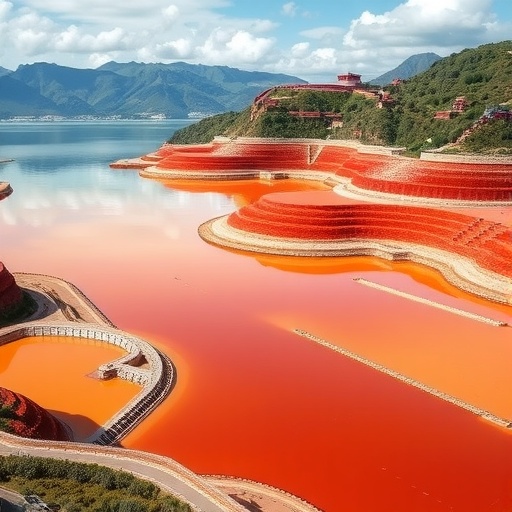The Longyangxia Reservoir, a significant hydrological structure located in the central part of China, has become a focal point for researchers aiming to understand the effects of climate change on freshwater ecosystems. Recent studies led by a team of experts, including Yao, Zhuge, and Yu, delve into the nuances of how thermal stratification – the layering of water with varying temperatures – in this reservoir is affected by shifts in climate patterns. This research not only highlights environmental changes but also offers insights into adaptive management strategies that can help mitigate adverse effects.
As climate change continues to escalate, the patterns of temperature variation in water bodies like the Longyangxia Reservoir have raised alarms. The researchers point out that the increasing temperatures lead to a significant alteration in thermal stratification processes over time. This phenomenon results in different layers of water developing distinct thermal properties, which can disrupt aquatic ecosystems and impact the species that rely on these environments for survival.
Understanding thermal stratification is crucial as it governs the distribution of heat in a reservoir. The top layer, or epilimnion, is generally warmer and well-lit, making it ideal for photosynthesis and supporting various biota. In contrast, the hypolimnion, or the bottom layer, remains cooler and darker. The interplay between these layers can influence oxygen levels, nutrient cycles, and the overall health of aquatic life. As highlighted in the research, disturbances in this balance due to climate change could have profound implications for biodiversity and water quality.
The data gathered from the Longyangxia Reservoir has been meticulously analyzed to project future scenarios. Researchers utilized hydrodynamic models to simulate heat distribution and predict how rising temperatures could further exacerbate the existing stratification patterns. Their findings indicate a trend of prolonged thermal stratification during late spring and summer months, which can potentially lead to hypoxic conditions in deeper waters, negatively impacting fish populations and other aquatic organisms.
In their discourse on adaptive management, the authors emphasize the necessity for proactive strategies to combat the challenges posed by thermal stratification changes. Implementing measures such as optimizing water release strategies and enhancing flow regulation can play pivotal roles in improving the resilience of the reservoir’s ecosystem. Such actions not only aim to mitigate thermal stratification effects but also promote a sustainable approach to water resource management in the face of climate uncertainties.
Moreover, the implications extend beyond local ecosystems. The Longyangxia Reservoir is part of a larger watershed that feeds into significant agricultural zones. The study underscores the importance of integrating findings from this research into broader regional water management practices. By adjusting water management mechanisms based on real-time data about thermal conditions, farmers can improve irrigation efficiency and crop health, ultimately guiding sustainable agricultural practices.
Encouragingly, the research has sparked a broader conversation about the role of reservoirs in climate adaptation strategies. As institutions and policymakers grapple with the complexities of climate change, the findings from the Longyangxia Reservoir serve as a compelling case study. It illustrates the critical need for comprehensive environmental monitoring and integration of scientific research into policy formulation and implementation.
Furthermore, the study sheds light on the role of public engagement in adaptive management measures. Involving local communities in monitoring and conservation activities can foster a sense of stewardship for these water bodies. As residents become stakeholders in the health of their environment, collective efforts can be mobilized to champion conservation initiatives, ultimately leading to enhanced water quality and ecological integrity.
Ultimately, ongoing monitoring and research efforts will be essential for adapting to the inevitable changes brought by climate change. The Longyangxia Reservoir stands as a testament to the urgency of addressing thermal stratification and its implications for freshwater ecosystems. As science continues to unveil the pathways through which climate change affects our water bodies, the need for informed decision-making and adaptive management strategies grows ever more pressing.
The implications of the Longyangxia Reservoir’s findings extend into several critical areas: the science of environmental monitoring, the economics of water resource management, and the art of ecological conservation. These themes resonate across various disciplines, emphasizing the interconnectedness of ecological health, societal needs, and sustainable practices. The integration of scientific research into practical management strategies remains an overarching theme, driving the need for continuous dialogue between researchers, policymakers, and the public.
In conclusion, the research conducted by Yao, Zhuge, and Yu serves as a clarion call for heightened awareness and action regarding the responses of aquatic ecosystems to climate change. The knowledge gleaned from their analysis of the Longyangxia Reservoir offers valuable insights that can steer both local and global initiatives towards more resilient and sustainable water management practices, ensuring that both nature and communities can thrive together even amid evolving environmental challenges.
Through rigorous analysis and robust models, the future of thermal stratification research as it pertains to climate change will undoubtedly continue to yield critical findings that inform and guide adaptive management strategies worldwide. As we stand at the intersection of climate science and ecological sustainability, the work of scientists in this field holds particular significance in navigating the complexities of our changing planet.
Subject of Research: The impact of climate change on thermal stratification in the Longyangxia Reservoir.
Article Title: Response of thermal stratification in Longyangxia reservoir to climate change and adaptive management.
Article References:
Yao, R., Zhuge, Y., Yu, X. et al. Response of thermal stratification in Longyangxia reservoir to climate change and adaptive management. Discov Sustain 6, 1226 (2025). https://doi.org/10.1007/s43621-025-01408-1
Image Credits: AI Generated
DOI: https://doi.org/10.1007/s43621-025-01408-1
Keywords: Climate change, thermal stratification, Longyangxia Reservoir, adaptive management, freshwater ecosystems, aquatic health, environmental monitoring, water resource management.




